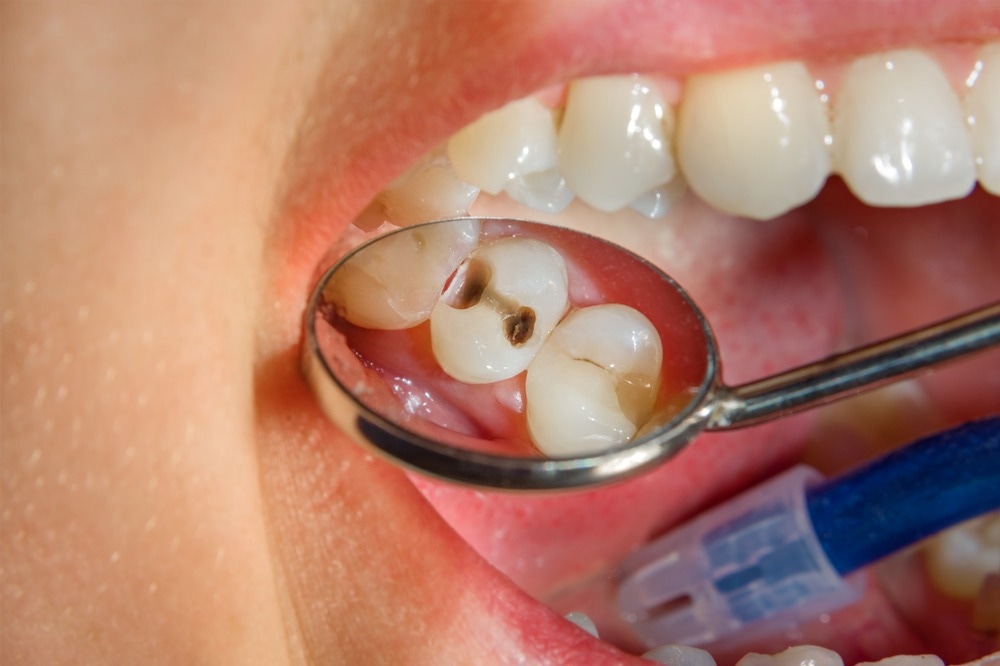A new study published in The Journal of the American Dental Association found an association between e-cigarette use or vaping and dental caries risk.
 Study: A comparison of the caries risk between patients who use vapes or electronic cigarettes and those who do not: A cross-sectional study. Image Credit: Sergii Kuchugurnyi/Shutterstock
Study: A comparison of the caries risk between patients who use vapes or electronic cigarettes and those who do not: A cross-sectional study. Image Credit: Sergii Kuchugurnyi/Shutterstock
Background
Vaping is a term used for e-cigarette use. This electronic device heats a vaping liquid, producing an aerosol when lit. However, e-cigarette use or vaping has been associated with lung injury and predisposes to fatal outcomes.
The vaping aerosol comprises a base (containing glycerin and propylene glycol), certain flavors, and is not devoid of nicotine. Some components of the vaping aerosol adhere to the oral cavity and promote biofilm formation and microbial adhesion. This includes the adherence of Streptococcus mutans to the enamel.
The sucrose content of the flavors also enhances biofilm formation and subsequently leads to the demineralization of the enamel. Further, the flavors negatively impact the commensal bacteria of the oral cavity.
Tobacco and vaping also harm periodontal health. Vaping negatively affects both radiographic and clinical peri-implant parameters. Similar to regular cigarettes, e-cigarettes also reduce the pH of the oral cavity, and thus, their use can accentuate risks for dental erosion and oral tissue damage.
There are very few studies on the relationship between the prevalence of caries and vaping or e-cigarette use. The present study assessed the risk of caries in individuals who regularly practiced vaping or e-cigarette use via The Caries Management by Risk Assessment tool.
About the study
Of the 13,216 patients, 52.1% were females, and 47.9% were males. Among the participants, 6.4% were in the age range of 16-25 years, 32.8% were between 26-40 years of age, and 60.7% were above 40 years of age. Overall, 13,080 individuals responded negatively when asked whether they had used or are currently using e-cigarettes or vaping. While 136 people affirmed their e-cigarettes or vaping statuses.
The participants were categorized based on their caries risk level as – high-risk 59.7%, moderate-risk 25.8%, and low-risk 14.5%. Meanwhile, data relating to the caries risk level was missing for 118 individuals. Therefore, a total of 13,098 individuals were selected for the evaluation, out of which 91 reported using vapes and e-cigarettes, and 13,007 said they did not.
Among those who answered “no” when enquired about their vapes or e-cigarette use status, 6.3% belonged to the 16-25-year age range, 32.6% to the 26-40-year age range, and 61.1% were more than 40 years old. In the group that responded “yes” when asked about current vaping or e-cigarette use, 19.1% were between 16-25 years of age, 52.9% were between 26-40 years old, and 27.9% were above 40 years of age.
Results
According to the Mann-Whitney U test, the caries risk level was significantly higher in the vape or e-cigarette group compared to the control group – with 59.6%, 25.9%, and 14.5% of the individuals in the control group belonging to the high-, moderate-, and low-caries risk categories, respectively, and 79.1%, 14.3%, and 6.6% those in the vape or e-cigarette group belonging to the high-, moderate-, and low-caries risk categories, respectively.
The multivariable logistic regression model adjusted for sex and age group revealed a significant difference in the caries risk level amongst the e-cigarette and vape users and control group. Of note, the control group had a lower risk for dental caries. Meanwhile, individuals above 40 had higher caries-risk levels compared to 16-25- and 26-40-year-olds. Additionally, females exhibited a lower dental caries risk than males.
Conclusion
The study concluded that patients who used vapes or e-cigarettes had a higher risk of dental caries. Therefore, all individuals who routinely vape or use e-cigarettes must be screened for oral health-related disease during their routine dental check-ups. For this, a dental history questionnaire may be used, wherein e-cigarette use or vaping should be included as a risk factor that increases the dental caries-risk level.
A more meticulous caries management program should be planned for patients who use e-cigarettes and vapes. A longitudinal assessment is further warranted to study the effects of vapes and e-cigarettes on tissues in the oral cavity and the risk for dental caries.